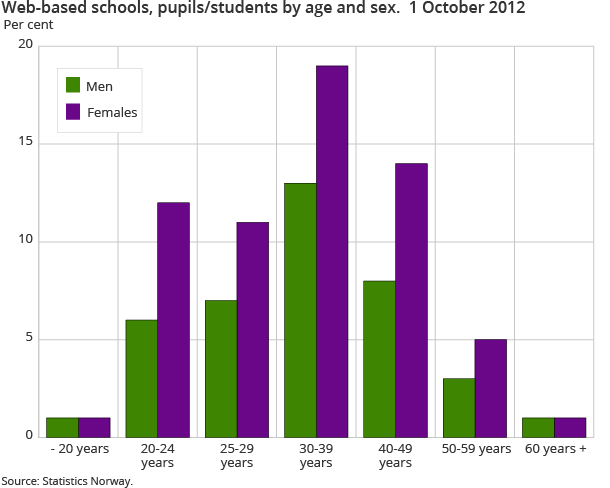Content
Published:
Updated:
This is an archived release.
The text and tables were corrected, 25 June 2014.
Decrease in web-based schools
Web-based schools had 17 000 participants in autumn 2012. This is a 12 per cent decrease from previous year. Over 15 000 participates in web-based courses without sessions. The number of course completions for the school year 2011/12 were 9 300.
| 2011-2012 | |||
|---|---|---|---|
| Completed educations | |||
| Total | Males | Females | |
| Corrected 24 June 2014. | |||
| Special field, total | 9 263 | 34 | 66 |
| General programmes | 178 | 53 | 47 |
| Humanities and arts | 596 | 28 | 72 |
| Education | 1 186 | 10 | 90 |
| Social sciences and law | 590 | 32 | 68 |
| Business and administration | 3 993 | 36 | 64 |
| Natural sciences, vocational and technical subjects | 534 | 67 | 33 |
| Health, welfare and sport | 1 203 | 7 | 93 |
| Primary industries | 16 | 38 | 63 |
| Transport and communications, safty and security and other services | 711 | 85 | 15 |
| Unspecified field of study | 256 | 35 | 65 |

Web-based schools are characterised as having a high degree of flexibility as both the teacher and participant can communicate independently of time and place. The different web-based schools offer different educational levels; upper secondary, tertiary vocational and university level. And web-based schools offer three different learning methods: location based, web-based with sessions and web-based without sessions. 89 per cent of the participants are in web-courses without sessions. Of these, 72 per cent are at upper secondary school level, 10 per cent at tertiary vocational school level, and 18 per cent at university level. Measured by number of participants, NKI Fjernundervisning was the largest in 2012, with 9 000 participants. Of these, 7 400, do courses at upper secondary school level.
Decrease of 2000 participants from previous year
The decrease in number of participants is highest at tertiary vocational school level with 19 per cent, and least at upper secondary school level with a 7.5 per cent decrease.
It is large variations among the schools in number of participants in 2012 compared to 2011. OPK Instituttet nettstudier had an increase of 115 per cent, and Fagbokforlaget nettskole increased with 81 per cent. While both Aftenskolen Høyres Studieforbund and Senter for eiendomsfag had an almost 50 per cent decrease in participants.
Course completions
The number of course completions for the school year 2011/12 were 9 200. Women make out 62 per cent and men 38 per cent of the participants; this share is also seen in course completions. 66 per cent of all course completions were by women for 2011/12. Women were in majority of course completions in 'teacher training' and 'pedagogy' and 'health, welfare and sports' with around 90 per cent of the completions in 2011/12.
Most course completions in business and administration subjects
As in 2010/11 the number of course completions was highest in 'business and administration subjects'. Within those subjects the course completions by level were 24 per cent at upper secondary school, 12 per cent at tertiary vocational level, and 64 per cent at university level. The share of women was 64 per cent in this subject. All together 45 per cent of the course completions were at upper secondary school, 10 per cent at tertiary vocational level, and 44 per cent at university level.
Most participants aged between 20 and 39 years
Participants aged from 20 to 29 years account for 35 per cent of all participants. The group between 30 and 39 accounts for 31 per cent, and 40 to 49 years 21 per cent. All together around 90 per cent of the participants are between 20 and 50 years old.
This page has been discontinued, see .
Contact
-
Statistics Norway's Information Centre
E-mail: informasjon@ssb.no
tel.: (+47) 21 09 46 42
